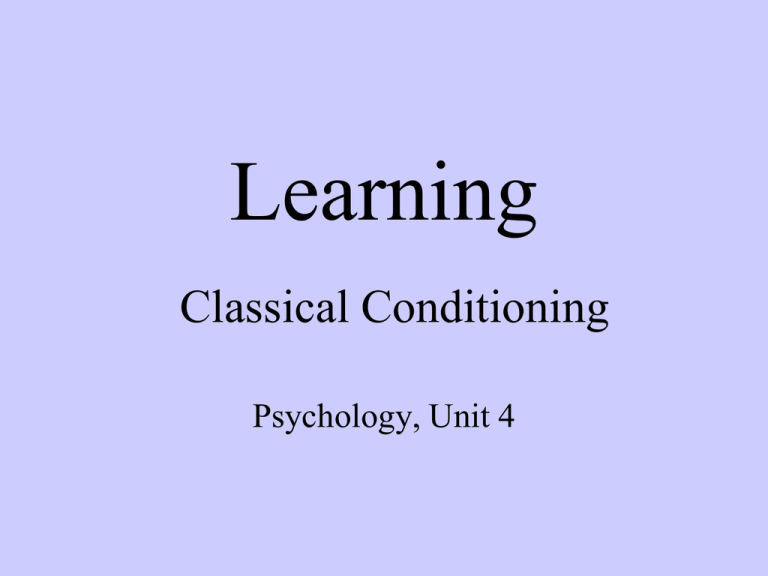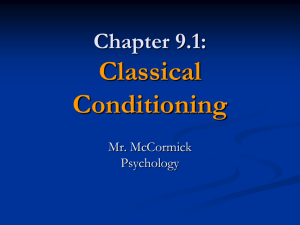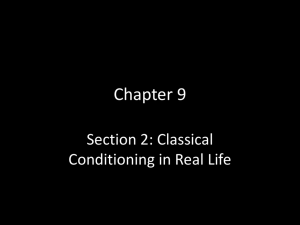1.-Classical-Conditioning
advertisement

Learning Classical Conditioning Psychology, Unit 4 Today’s Objectives • Identify and apply each of the 3 types of learning to life • Relate the appropriate psychologist to their area of specialty in learning Answer the following questions: 1. Have you ever gotten sick after eating something and now you can’t look at that type of food? 2. Is it easy to teach a dog to come to you? Is it easy to teach a dog not to chase rabbits in your yard? 3. Do you think kids that have violent parents will become violent themselves? 3 Types of Learning 1. Classical Conditioning 2. Operant Conditioning 3. Cognitive Learning 1. Classical Conditioning • Involves reflexive behaviors that automatically follow a stimulus. –While watching a horror movie, you may tense up when you hear scary music begin to play –If someone jumps out at you, you scream and put your hands up in a defensive position –Feeling ill when you see a food that you once threw up 1. Ivan Pavlov • The father of classical (Pavlovian) conditioning –Noticed that dogs salivate when they see food. –Began ringing a bell, then placing food in front of dog –After a while, dog salivates when bell rings even when there is no food present Pavlov loved his work! Can’t you tell? Conditioned and Unconditioned Stimuli 1. Unconditioned Stimulus: the “thing” your body reflexively reacts to without being taught. a. Stomach flu = vomit 2. Conditioned Stimulus: the “thing” (sound, smell, touch etc) you teach a new reflex to respond to b. Smell cinnamon candle while you have the stomach flu; now you get nauseas any time you smell cinnamon 3. Identify US and CS: I used to wake up when my body and mind felt rested. Now, the second my daughter cries, I wake up and run to her room. Classically Condition your Pulse Post-Traumatic Stress Disorder • The intensity of the traumatic incident is such that stimuli that were present at the time of the trauma (unconditioned stimulus) become associated with fear and arousal symptoms • Henceforth similar stimuli (now conditioned) trigger responses as if the trauma was recurring. 1. Use of Classical Conditioning in People • Therapists use Classical Conditioning to treat fears and disorders in people – EX: Agoraphobics are people who have an abnormal fear of leaving their homes. This is often treated w/ CC. The Therapist teaches the patient deep relaxation techniques. While in deep relaxation, they are asked to picture opening the front door, then going outside, then to a baseball game. Eventually, actually doing these things reminds the patient of being relaxed and the phobia is cured! 1.Use of Classical Conditioning in People • Medical Doctors have used CC to treat autoimmune disorders w/o drugs that usually have terrible side effects. –They pair an immunosuppressant w/ a smell or food and after a few treatments that smell or food will suppress the immune system w/o the use of the drug. Exit Ticket 1. List the 3 types of learning 2. Who is known as the founder of classical conditioning? 3. Summarize the experiment that proves classical conditioning





